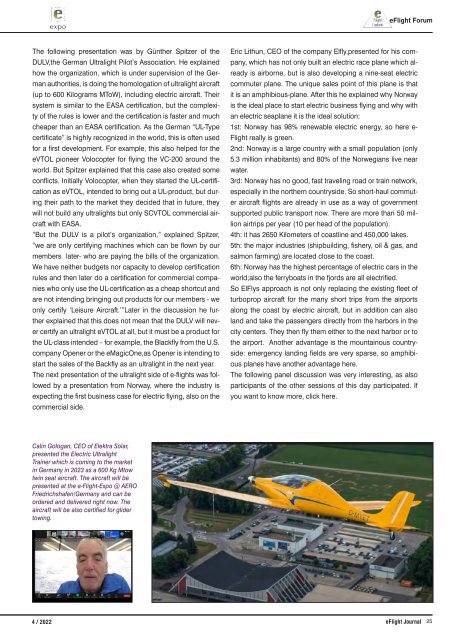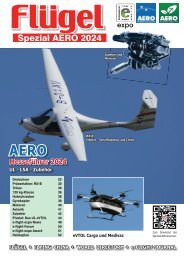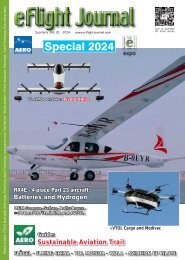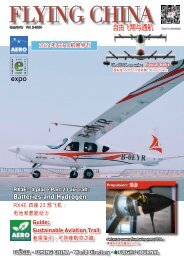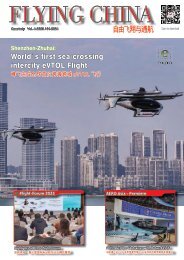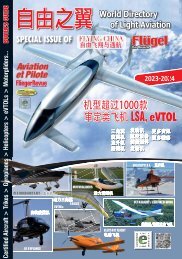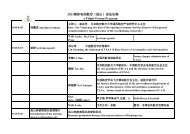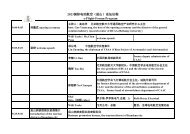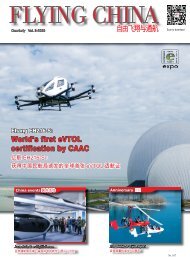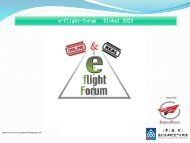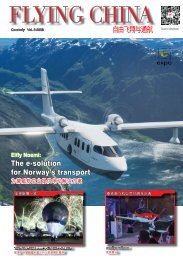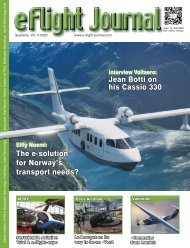e-flight-Journal_4-2022
The E-flight Magazin the world of electric and sustainable aviation. Evtols and Aircraft
The E-flight Magazin
the world of electric and sustainable aviation.
Evtols and Aircraft
Create successful ePaper yourself
Turn your PDF publications into a flip-book with our unique Google optimized e-Paper software.
eFlight Forum<br />
The following presentation was by Günther Spitzer of the<br />
DULV,the German Ultralight Pilot’s Association. He explained<br />
how the organization, which is under supervision of the German<br />
authorities, is doing the homologation of ultralight aircraft<br />
(up to 600 Kilograms MToW), including electric aircraft. Their<br />
system is similar to the EASA certification, but the complexity<br />
of the rules is lower and the certification is faster and much<br />
cheaper than an EASA certification. As the German “UL-Type<br />
certificate” is highly recognized in the world, this is often used<br />
for a first development. For example, this also helped for the<br />
eVTOL pioneer Volocopter for flying the VC-200 around the<br />
world. But Spitzer explained that this case also created some<br />
conflicts. Initially Volocopter, when they started the UL-certification<br />
as eVTOL, intended to bring out a UL-product, but during<br />
their path to the market they decided that in future, they<br />
will not build any ultralights but only SCVTOL commercial aircraft<br />
with EASA.<br />
“But the DULV is a pilot’s organization,” explained Spitzer,<br />
“we are only certifying machines which can be flown by our<br />
members later- who are paying the bills of the organization.<br />
We have neither budgets nor capacity to develop certification<br />
rules and then later do a certification for commercial companies<br />
who only use the UL-certification as a cheap shortcut and<br />
are not intending bringing out products for our members - we<br />
only certify ‘Leisure Aircraft.’”Later in the discussion he further<br />
explained that this does not mean that the DULV will never<br />
certify an ultralight eVTOL at all, but it must be a product for<br />
the UL-class intended – for example, the Blackfly from the U.S.<br />
company Opener or the eMagicOne,as Opener is intending to<br />
start the sales of the Backfly as an ultralight in the next year.<br />
The next presentation of the ultralight side of e-<strong>flight</strong>s was followed<br />
by a presentation from Norway, where the industry is<br />
expecting the first business case for electric flying, also on the<br />
commercial side.<br />
Eric Lithun, CEO of the company Elfly,presented for his company,<br />
which has not only built an electric race plane which already<br />
is airborne, but is also developing a nine-seat electric<br />
commuter plane. The unique sales point of this plane is that<br />
it is an amphibious-plane. After this he explained why Norway<br />
is the ideal place to start electric business flying and why with<br />
an electric seaplane it is the ideal solution:<br />
1st: Norway has 98% renewable electric energy, so here e-<br />
Flight really is green.<br />
2nd: Norway is a large country with a small population (only<br />
5.3 million inhabitants) and 80% of the Norwegians live near<br />
water.<br />
3rd: Norway has no good, fast traveling road or train network,<br />
especially in the northern countryside. So short-haul commuter<br />
aircraft <strong>flight</strong>s are already in use as a way of government<br />
supported public transport now. There are more than 50 million<br />
airtrips per year (10 per head of the population).<br />
4th: it has 2650 Kilometers of coastline and 450,000 lakes.<br />
5th: the major industries (shipbuilding, fishery, oil & gas, and<br />
salmon farming) are located close to the coast.<br />
6th: Norway has the highest percentage of electric cars in the<br />
world;also the ferryboats in the fjords are all electrified.<br />
So ElFlys approach is not only replacing the existing fleet of<br />
turboprop aircraft for the many short trips from the airports<br />
along the coast by electric aircraft, but in addition can also<br />
land and take the passengers directly from the harbors in the<br />
city centers. They then fly them either to the next harbor or to<br />
the airport. Another advantage is the mountainous countryside:<br />
emergency landing fields are very sparse, so amphibious<br />
planes have another advantage here.<br />
The following panel discussion was very interesting, as also<br />
participants of the other sessions of this day participated. If<br />
you want to know more, click here.<br />
Calin Gologan, CEO of Elektra Solar,<br />
presented the Electric Ultralight<br />
Trainer which is coming to the market<br />
in Germany in 2023 as a 600 Kg Mtow<br />
twin seat aircraft. The aircraft will be<br />
presented at the e-Flight-Expo @ AERO<br />
Friedrichshafen/Germany and can be<br />
ordered and delivered right now. The<br />
aircraft will be also certified for glider<br />
towing.<br />
4 / <strong>2022</strong><br />
e Flight <strong>Journal</strong><br />
25


